Prediction of Friction Coefficient for Ductile Cast Iron Using Artificial Neural Network Methodology Based on Experimental Investigation
Abstract
1. Introduction
2. Materials and Methods
2.1. Materials
2.2. Methods
2.2.1. Annealing
2.2.2. Austenitic (Isothermal) Process
2.2.3. Sliding Wear Test
- Weighing the sample before each test using a sensitive balance with a sensitivity of 0.0001 g, where the weight of the specimen before the test was (3.0195 g);
- Determining the parameter whose effect is to be studied on the wear rate (e.g., sliding time) and fixing all other parameters (normal load and sliding speed);
- Installing the sample to be tested with the wear device, placing it perpendicular to the sliding disk, and then operating the device for specified periods. The piece is weighed after the test and to calculate the wear rate; Equation (2) was used [20]
3. Methodology of Artificial Neural Network
4. Results and Discussion
4.1. Experimental Results
4.2. Data Collection and ANN Results
- The use of the Levenberg–Marquardt back-propagation algorithm enabled the training stage to be reached;
- Two ANN structures were employed, one of which had a single hidden layer and the second of which contained a double hidden layer;
- To assess the ANN model, the mean squared error (MSE) and coefficient of determination (R2) must be calculated;
- A trial-and-error technique was used to control the number of neurons in the hidden layer;
- The sigmoid function enabled the hidden layer to be activated, whilst the purline activation function was used to activate the output signal.
4.2.1. Best Validation
4.2.2. ANN Model Performance
4.3. Results Validation
5. Conclusions
- The COF decreased as the sliding speed increased under a constant load. Moreover, the COF displayed a similar pattern at a constant sliding speed under a high load;
- There was a reduction in the wear rate as the sliding speed increased. To be more precise, an increase in sliding speed from 70 cm/s to 114 cm/s caused a decline in the wear rate from (8.74 to 0.95) × 10−8 (g/cm) at the start of the experiment and from (9.8 to 1.82) × 10−8 (g/cm) at the end of the experiment;
- The wear rate increases with the increase in the applied load at constant sliding speed conditions due to the plastic deformation between the two surfaces, thus increasing the real contact area;
- The wear rate value was found to be lower for the bainite structure than the ferrite structure due to the higher hardness of the bainite structure;
- The ANN models with single and double hidden layers are able to accurately predict the friction coefficients;
- The ANN containing a single hidden layer was found to be more accurate than the that containing a double hidden layer. On the other hand, the best performance during the validation stage was recorded at an MSE of 0.012346 at epoch 20 in the single layer and 0.038333 at epoch 8 in the double hidden layer.
Author Contributions
Funding
Conflicts of Interest
References
- Fan, Y.; Gui, X.; Liu, M.; Wang, X.; Bai, B.; Gao, G. Effect of Microstructure on Wear and Rolling Contact Fatigue Behaviors of Bainitic/Martensitic Rail Steels. Wear 2022, 508–509, 204474. [Google Scholar] [CrossRef]
- Palavar, O.; Özyürek, D.; Kalyon, A. Artificial Neural Network Prediction of Aging Effects on the Wear Behavior of IN706 Superalloy. Mater. Des. 2015, 82, 164–172. [Google Scholar] [CrossRef]
- Nayak, D.; Ray, N.; Sahoo, R.; Debata, M. Analysis of Tribological Performance of Cu Hybrid Composites Reinforced with Graphite and TiC Using Factorial Techniques. Tribol. Trans. 2014, 57, 908–918. [Google Scholar] [CrossRef]
- Hanon, M.M.; Ghaly, A.; Zsidai, L.; Klébert, S. Tribological Characteristics of Digital Light Processing (DLP) 3D Printed Graphene/Resin Composite: Influence of Graphene Presence and Process Settings. Mater. Des. 2022, 218, 110718. [Google Scholar] [CrossRef]
- Hanon, M.M.; Zsidai, L. Comprehending the Role of Process Parameters and Filament Color on the Structure and Tribological Performance of 3D Printed PLA. J. Mater. Res. Technol. 2021, 15, 647–660. [Google Scholar] [CrossRef]
- Kazi, M.-K.; Eljack, F.; Mahdi, E. Predictive ANN Models for Varying Filler Content for Cotton Fiber/PVC Composites Based on Experimental Load Displacement Curves. Compos. Struct. 2020, 254, 112885. [Google Scholar] [CrossRef]
- Arabi Bulaghi, Z.; Habibizad Navin, A.; Hosseinzadeh, M.; Rezaee, A. World Competitive Contest-Based Artificial Neural Network: A New Class-Specific Method for Classification of Clinical and Biological Datasets. Genomics 2021, 113, 541–552. [Google Scholar] [CrossRef]
- Winiczenko, R.; Salat, R.; Awtoniuk, M. Estimation of Tensile Strength of Ductile Iron Friction Welded Joints Using Hybrid Intelligent Methods. Trans. Nonferrous Met. Soc. China 2013, 23, 385–391. [Google Scholar] [CrossRef]
- Vaira Vignesh, R.; Padmanaban, R. Artificial Neural Network Model for Predicting the Tensile Strength of Friction Stir Welded Aluminium Alloy AA1100. Mater. Today Proc. 2018, 5, 16716–16723. [Google Scholar] [CrossRef]
- Zmak, I.; Filetin, T. Mechanical Properties of Ductile Cast Iron Determined by Neural Networks. In Proceedings of the Third International Conference on Modeling, Simulation and Applied Optimization, Sharjah, United Arab Emirates, 20–22 January 2009; pp. 20–22. [Google Scholar]
- Perzyk, M.; Kochański, A.W. Prediction of Ductile Cast Iron Quality by Artificial Neural Networks. J. Mater. Process. Technol. 2001, 109, 305–307. [Google Scholar] [CrossRef]
- Anand, K.; Barik, B.K.; Tamilmannan, K.; Sathiya, P. Artificial Neural Network Modeling Studies to Predict the Friction Welding Process Parameters of Incoloy 800H Joints. Eng. Sci. Technol. 2015, 18, 394–407. [Google Scholar] [CrossRef]
- Kumar, S.; Priyadarshan; Ghosh, S.K. Statistical and Artificial Neural Network Technique for Prediction of Performance in AlSi10Mg-MWCNT Based Composite Materials. Mater. Chem. Phys. 2021, 273, 125136. [Google Scholar] [CrossRef]
- Xiao, G.; Zhu, Z. Friction Materials Development by Using DOE/RSM and Artificial Neural Network. Tribol. Int. 2010, 43, 218–227. [Google Scholar] [CrossRef]
- Aleksendrić, D. Neural Network Prediction of Brake Friction Materials Wear. Wear 2010, 268, 117–125. [Google Scholar] [CrossRef]
- Prudhvi Sai, P.; Roshan Balu, T.M.B.; Vaira Vignesh, R.; Bhaskara Sastry, C.V.; Padmanaban, R. Artificial Neural Network Models for Predicting the Corrosion Behavior of Friction Stir Processed AA5083. Mater. Today Proc. 2021, 46, 7215–7219. [Google Scholar] [CrossRef]
- Soni, A.; Yusuf, M.; Beg, M.; Hashmi, A.W. An Application of Artificial Neural Network (ANN) to Predict the Friction Coefficient of Nuclear Grade Graphite. Mater. Today Proc. 2022, 68, 701–709. [Google Scholar] [CrossRef]
- El-Emam, M.A.; Zhou, L.; Yasser, E.; Bai, L.; Shi, W. Computational Methods of Erosion Wear in Centrifugal Pump: A State-of-the-Art Review. Arch. Comput. Methods Eng. 2022, 29, 3789–3814. [Google Scholar] [CrossRef]
- Tsukizoe, T.; Ohmae, N. Friction and Wear of Advanced Composite Materials. Fibre Sci. Technol. 1983, 18, 265–286. [Google Scholar] [CrossRef]
- Nordin, N.A.; Yussof, F.M.; Kasolang, S.; Salleh, Z.; Ahmad, M.A. Wear Rate of Natural Fibre: Long Kenaf Composite. Procedia Eng. 2013, 68, 145–151. [Google Scholar] [CrossRef]
- Mohd Noor, C.W.; Mamat, R.; Najafi, G.; Mat Yasin, M.H.; Ihsan, C.K.; Noor, M.M. Prediction of Marine Diesel Engine Performance by Using Artificial Neural Network Model. J. Mech. Eng. Sci. 2016, 10, 1917–1930. [Google Scholar] [CrossRef]
- Pontes, F.J.; de Paiva, A.P.; Balestrassi, P.P.; Ferreira, J.R.; Silva, M.B. da Optimization of Radial Basis Function Neural Network Employed for Prediction of Surface Roughness in Hard Turning Process Using Taguchi’s Orthogonal Arrays. Expert. Syst. Appl. 2012, 39, 7776–7787. [Google Scholar] [CrossRef]
- Vastrad, C. Performance Analysis of Neural Network Models for Oxazolines and Oxazoles Derivatives Descriptor Dataset. arXiv 2013, arXiv:1312.2853. [Google Scholar]
- Ahmadi, M.H.; Baghban, A.; Sadeghzadeh, M.; Zamen, M.; Mosavi, A.; Shamshirband, S.; Kumar, R.; Mohammadi-Khanaposhtani, M. Evaluation of Electrical Efficiency of Photovoltaic Thermal Solar Collector. Eng. Appl. Comput. Fluid Mech. 2020, 14, 545–565. [Google Scholar] [CrossRef]
- Ameen, H.A.; Hassan, K.S.; Mubarak, E.M.M.; Ameen, H.A.; Hassan, K.S.; Mubarak, E.M.M. Effect of Loads, Sliding Speeds and Times on the Wear Rate for Different Materials. Am. J. Sci. Ind. Res. 2011, 2, 99–106. [Google Scholar] [CrossRef]
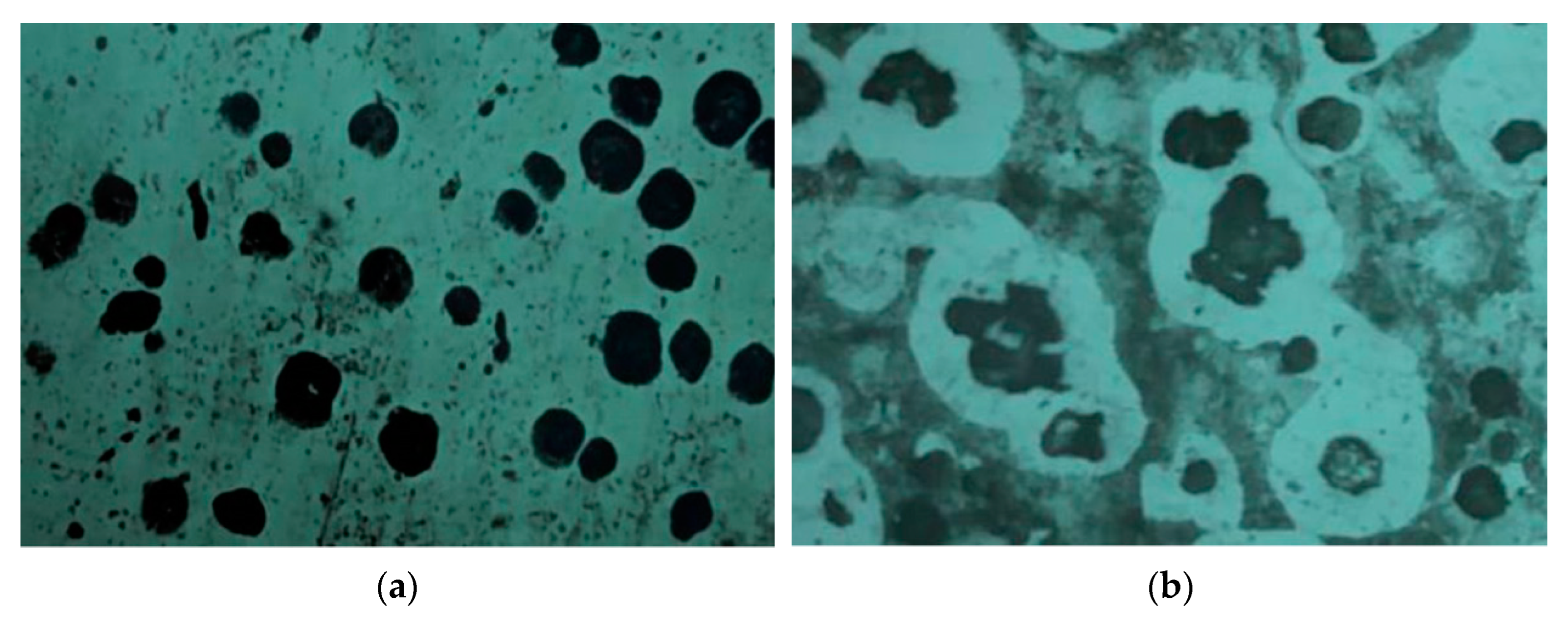
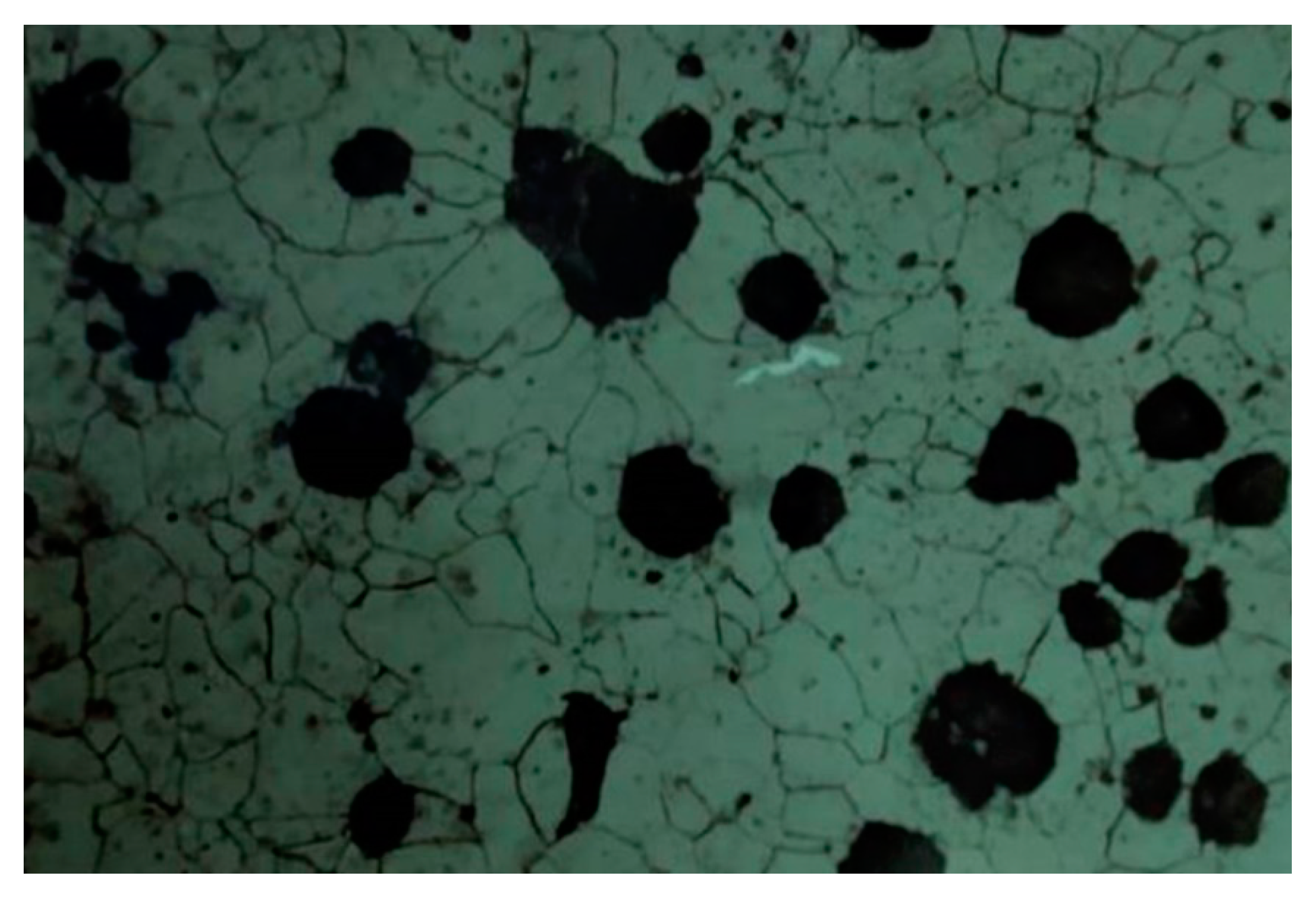

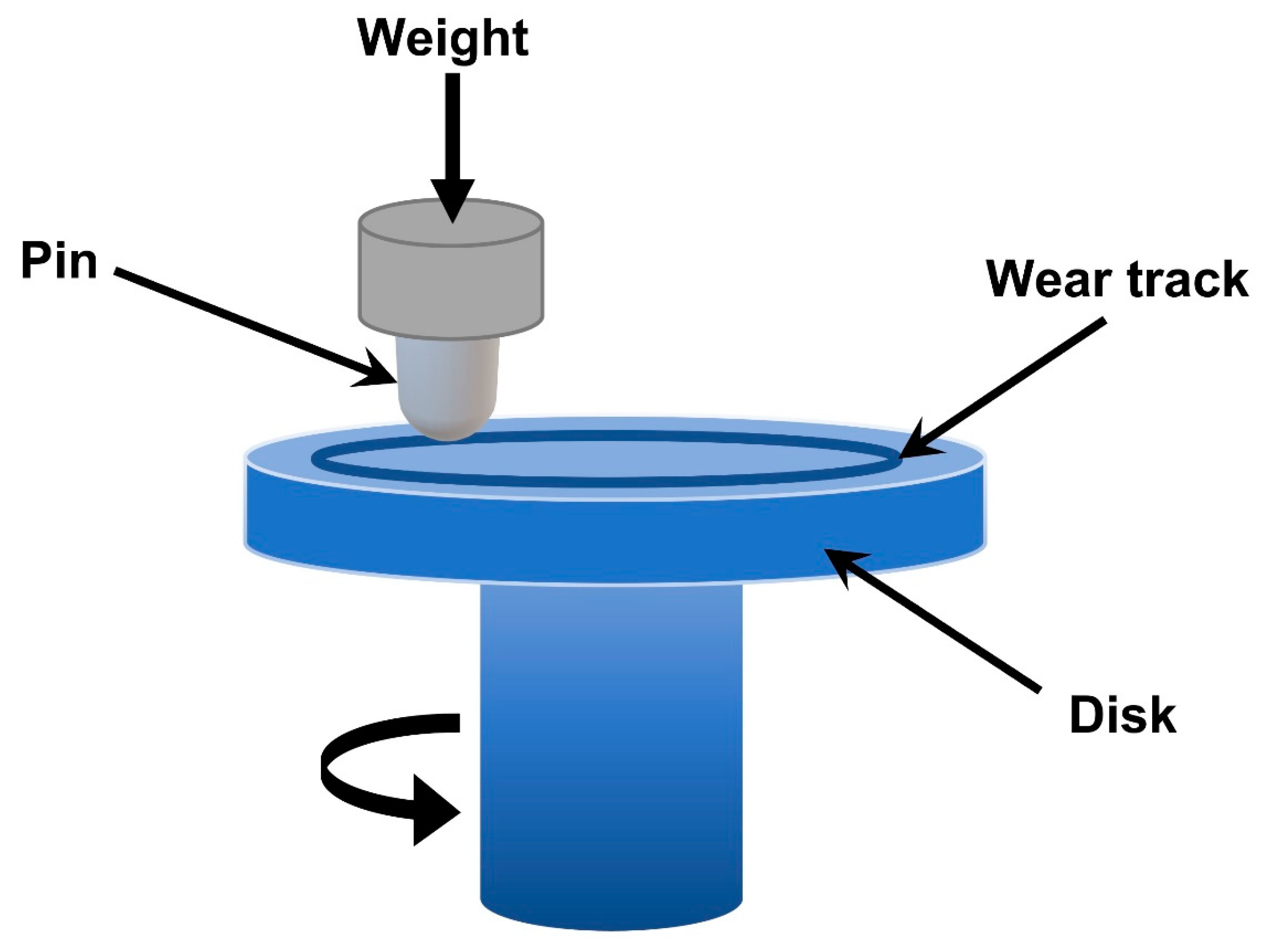
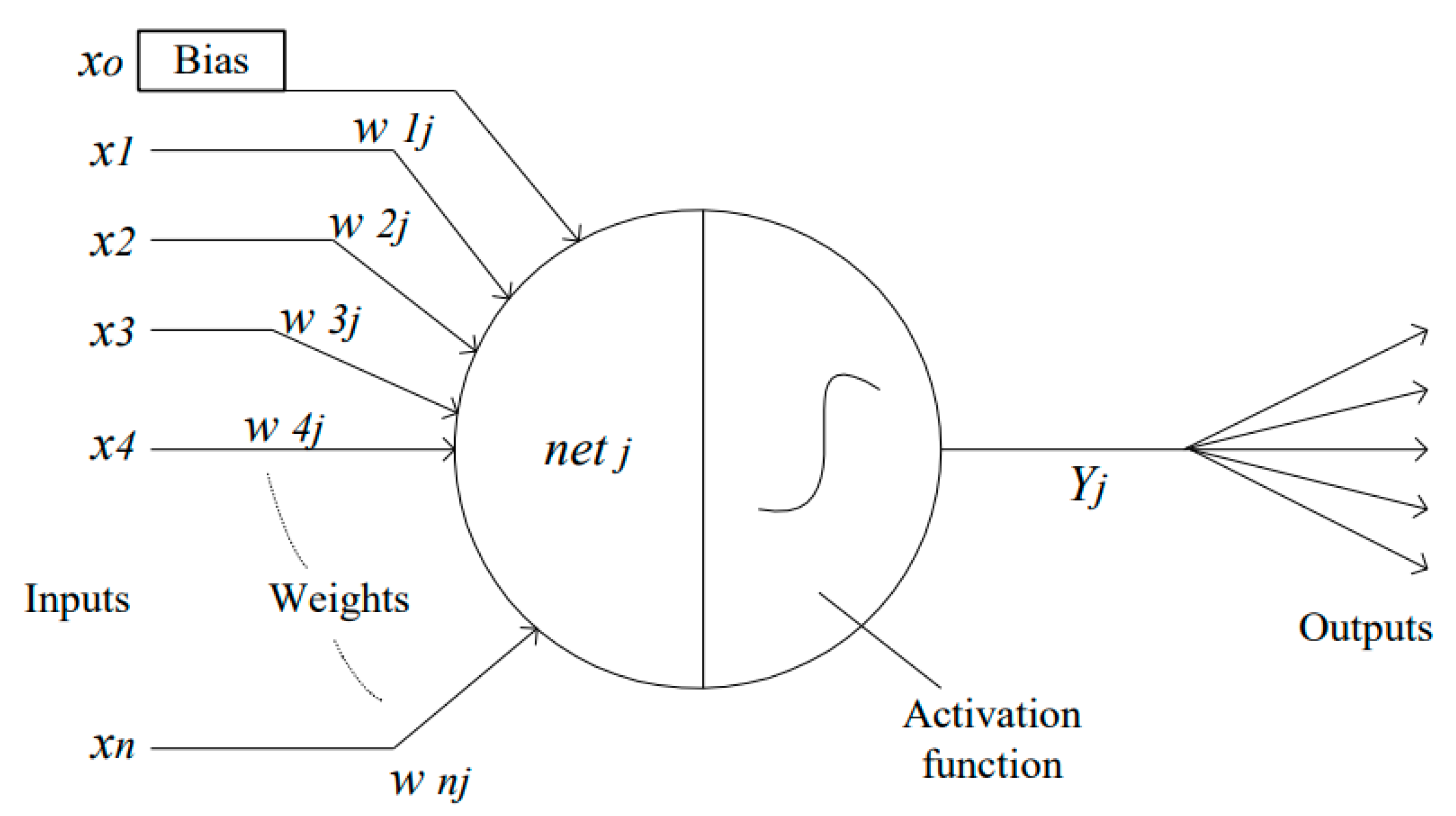
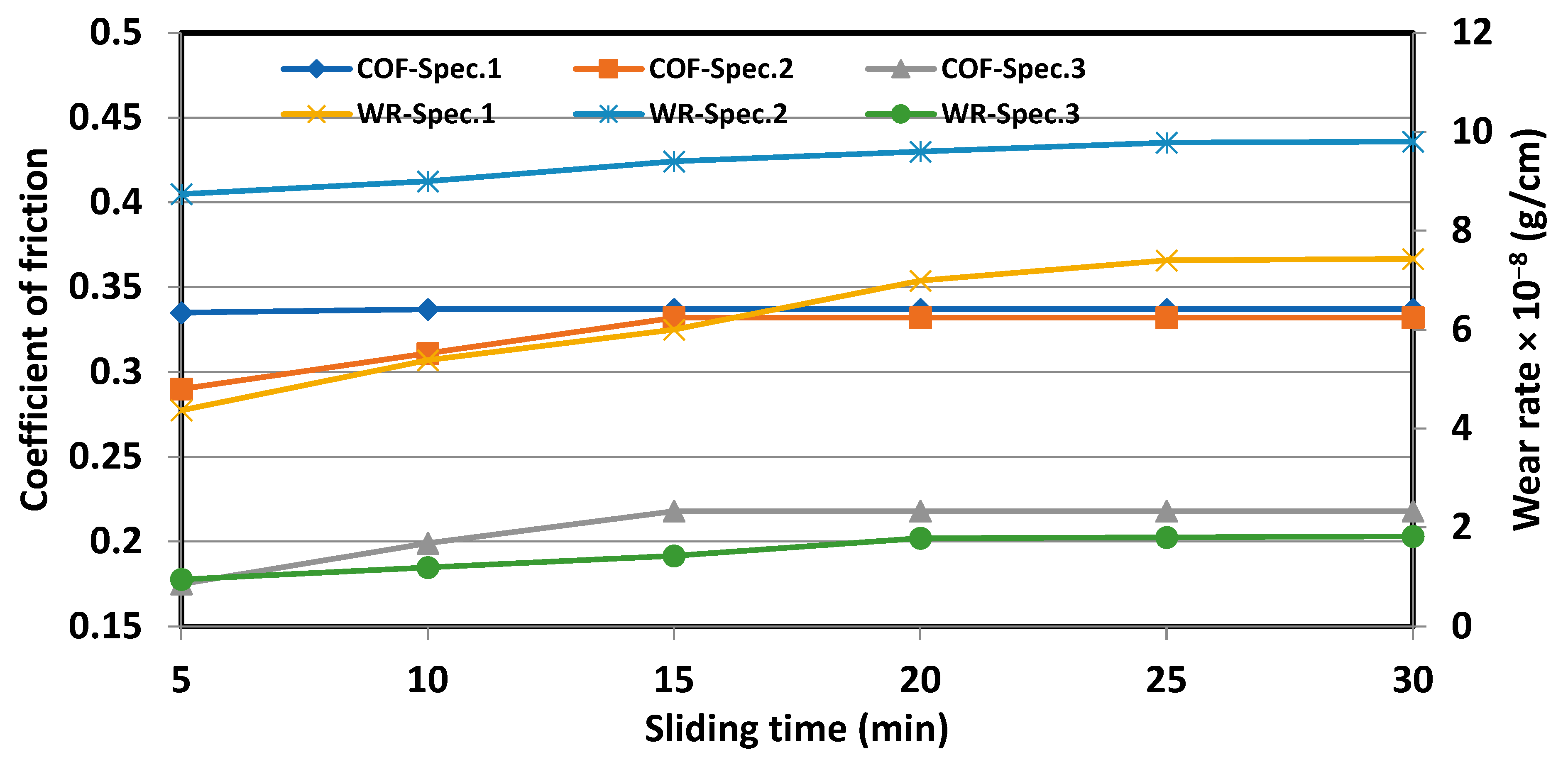
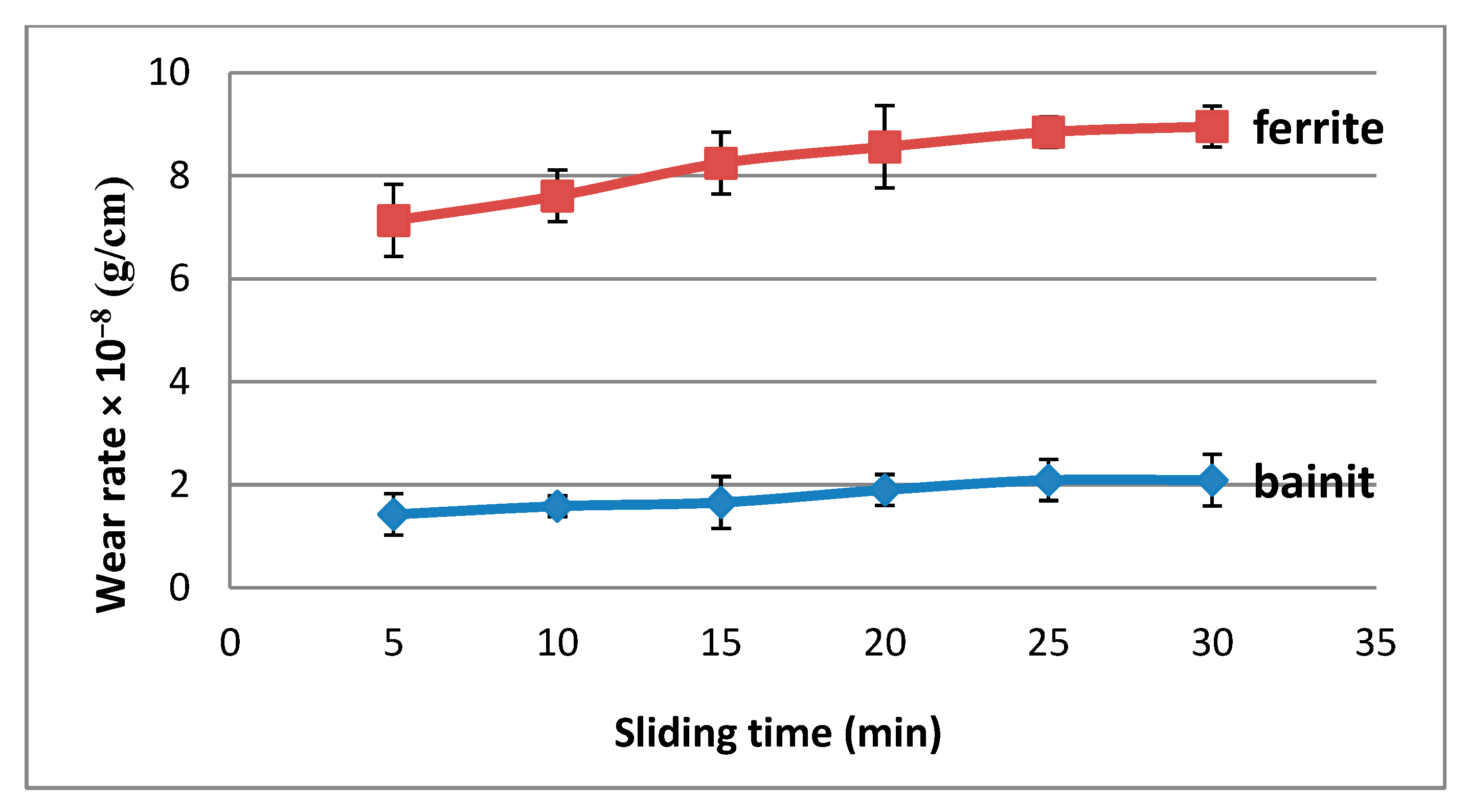


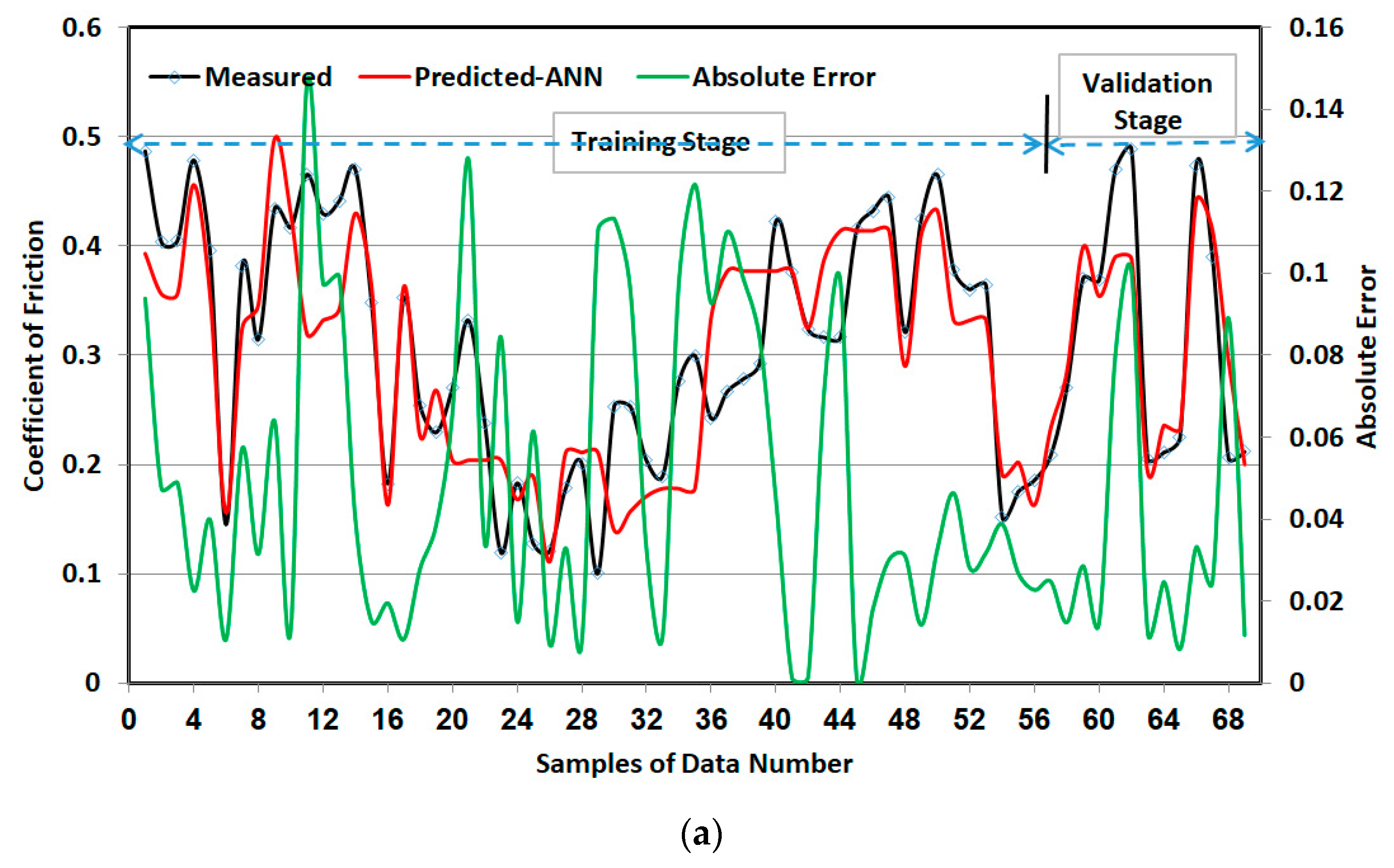
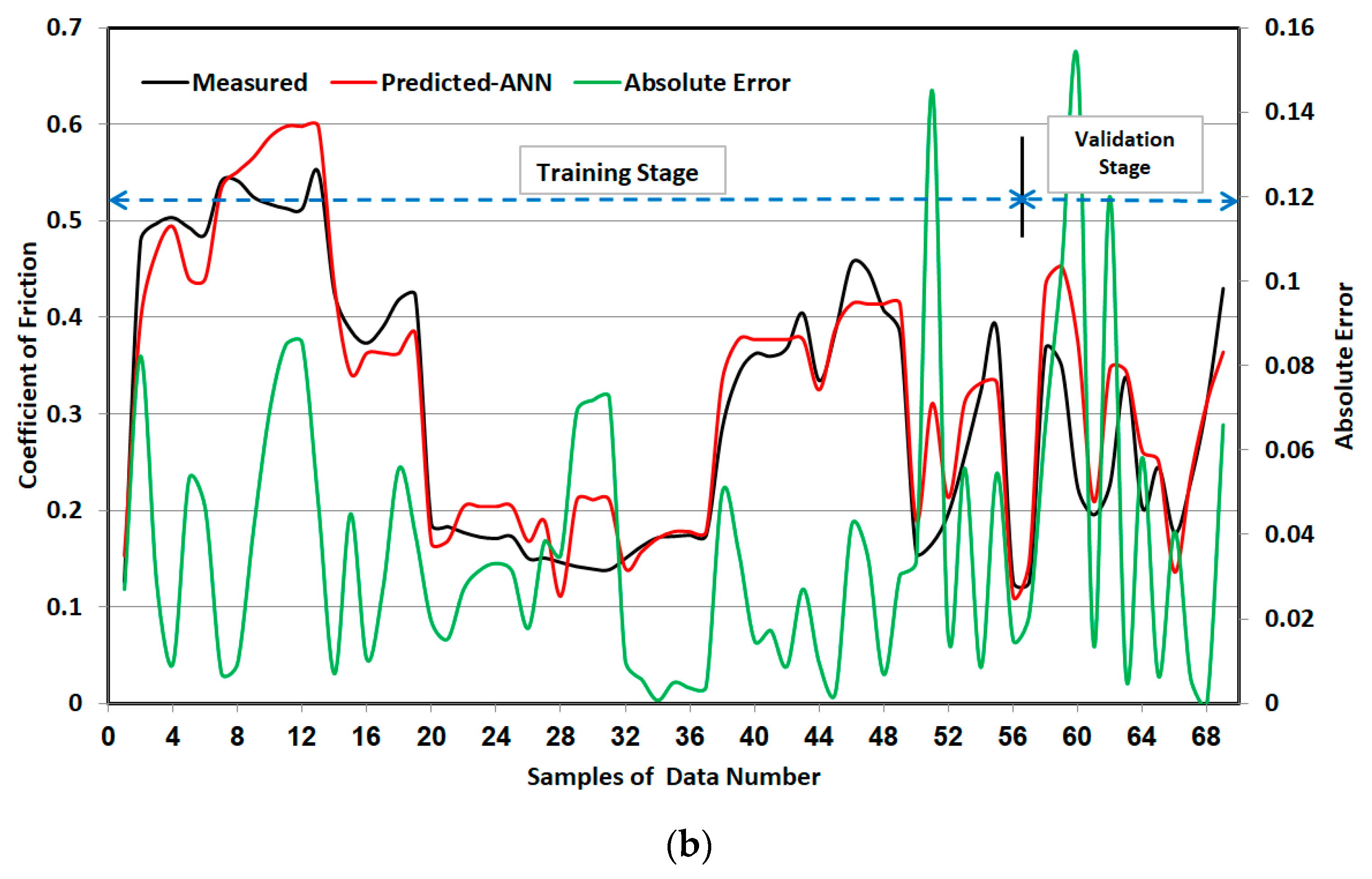
| Carbon | Silicon | Manganese | Magnesium | Phosphorus | Sulfur | Copper | Iron |
|---|---|---|---|---|---|---|---|
| 3.25% | 2.25% | 0.14% | 0.030% | 0.005% | 0.005% | 0.32% | 94% |
| Sliding Time (min) | Weight before Testing (g) | Weight after Testing (g) | Weight Loss (g) |
|---|---|---|---|
| 5 | 3.0195 | 3.0192 | 0.0003 |
| 10 | 3.0192 | 3.0185 | 0.0007 |
| 15 | 3.0185 | 3.0176 | 0.0009 |
| 20 | 3.0176 | 3.0162 | 0.0014 |
| 25 | 3.0162 | 3.0146 | 0.0016 |
| 30 | 3.0146 | 3.0135 | 0.0011 |
| Type | No. of Nodules (mm2) | Diameter (μm) | Load (N) | Sliding Speed (cm/s) |
|---|---|---|---|---|
| Spec.1 | 355 | 20.9 | 17.338 | 70 |
| Spec. 2 | 335 | 20.9 | 52.015 | 70 |
| Spec. 3 | 335 | 20.9 | 52.015 | 114 |
| No. | Load (N) | Time (min) | Number of Grains/mm2 | Diameter of Grain (μm) | Friction Coefficient |
|---|---|---|---|---|---|
| 1 | 17.33 | 5 | 256 | 30.6 | 0.293 |
| 2 | 17.33 | 10 | 256 | 30.6 | 0.356 |
| 3 | 17.33 | 15 | 256 | 30.6 | 0.356 |
| 4 | 17.33 | 20 | 256 | 30.6 | 0.356 |
| 5 | 17.33 | 25 | 256 | 30.6 | 0.356 |
| 6 | 17.33 | 30 | 256 | 30.6 | 0.356 |
| 7 | 34.67 | 5 | 256 | 30.6 | 0.325 |
| 8 | 34.67 | 10 | 256 | 30.6 | 0.346 |
| 9 | 34.67 | 15 | 256 | 30.6 | 0.393 |
| 10 | 34.67 | 20 | 256 | 30.6 | 0.393 |
| 11 | 34.67 | 25 | 256 | 30.6 | 0.393 |
| 12 | 34.67 | 30 | 256 | 30.6 | 0.393 |
| 13 | 52.01 | 5 | 256 | 30.6 | 0.314 |
| 14 | 52.01 | 10 | 256 | 30.6 | 0.321 |
| 15 | 52.01 | 15 | 256 | 30.6 | 0.335 |
| 16 | 34.67 | 5 | 429 | 20.5 | 0.168 |
| 17 | 34.67 | 10 | 429 | 20.5 | 0.189 |
| 18 | 34.67 | 15 | 429 | 20.5 | 0.211 |
| 19 | 34.67 | 20 | 429 | 20.5 | 0.211 |
| 20 | 34.67 | 25 | 429 | 20.5 | 0.211 |
Publisher’s Note: MDPI stays neutral with regard to jurisdictional claims in published maps and institutional affiliations. |
© 2022 by the authors. Licensee MDPI, Basel, Switzerland. This article is an open access article distributed under the terms and conditions of the Creative Commons Attribution (CC BY) license (https://creativecommons.org/licenses/by/4.0/).
Share and Cite
Khalaf, A.A.; Hanon, M.M. Prediction of Friction Coefficient for Ductile Cast Iron Using Artificial Neural Network Methodology Based on Experimental Investigation. Appl. Sci. 2022, 12, 11916. https://doi.org/10.3390/app122311916
Khalaf AA, Hanon MM. Prediction of Friction Coefficient for Ductile Cast Iron Using Artificial Neural Network Methodology Based on Experimental Investigation. Applied Sciences. 2022; 12(23):11916. https://doi.org/10.3390/app122311916
Chicago/Turabian StyleKhalaf, Ahmad A., and Muammel M. Hanon. 2022. "Prediction of Friction Coefficient for Ductile Cast Iron Using Artificial Neural Network Methodology Based on Experimental Investigation" Applied Sciences 12, no. 23: 11916. https://doi.org/10.3390/app122311916
APA StyleKhalaf, A. A., & Hanon, M. M. (2022). Prediction of Friction Coefficient for Ductile Cast Iron Using Artificial Neural Network Methodology Based on Experimental Investigation. Applied Sciences, 12(23), 11916. https://doi.org/10.3390/app122311916










